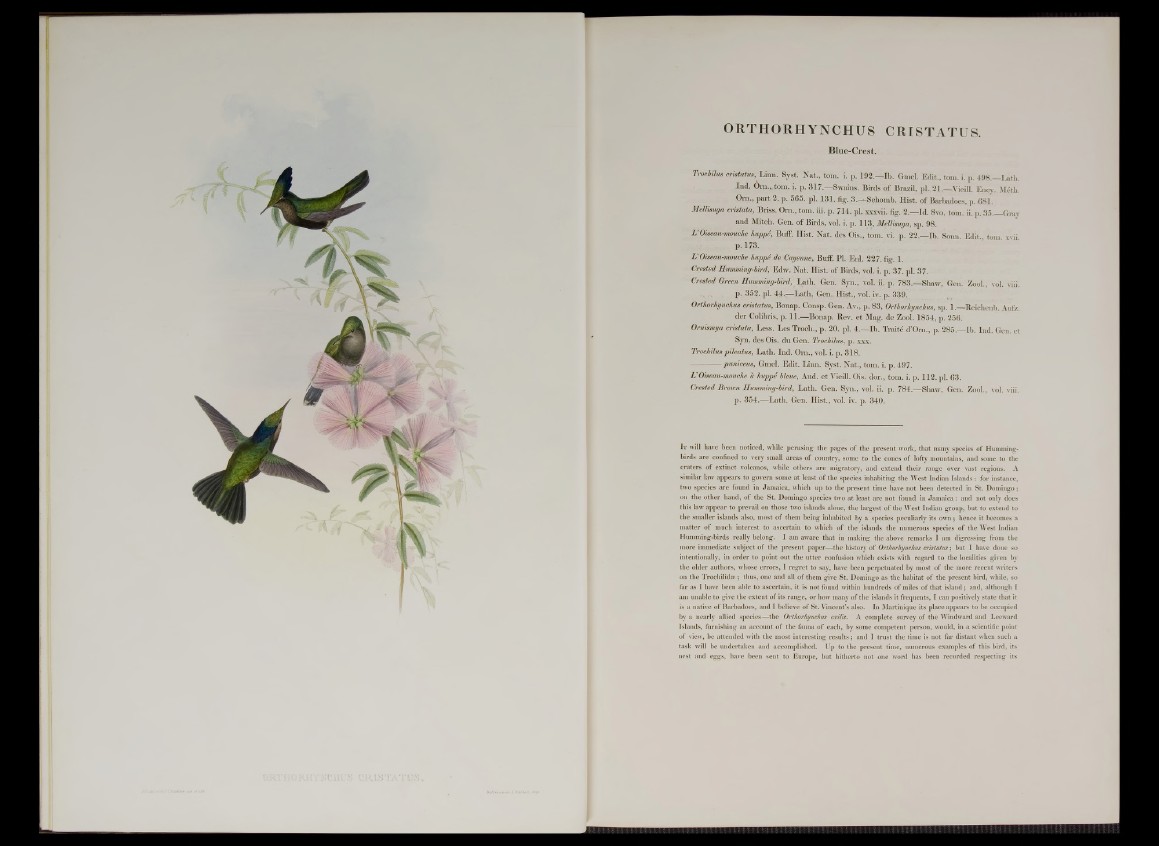
ORTHORHYNCHUS CRISTATUS .
Blue-Crest.
Trochüus cristatus! Linn. Syst. N a t , tom. i. p. 192.— Ib . Gmel. E d i t, tom. i. p. 498.—Lath.
I n d ( O m „ tom . i. p. 317.— Swains. Birds o f Brazil, pl., 21.—Vieill. Ency. Méth.
O m , p a rt 2. p. 565. pi. 131. fig. , 3 ^-Sçhomb. Hist, o f Barbadoes, p. 681.
Mellimga cristata, Briss. O m , tom. iii. p. 714. pi. xxxvii. fig. 2 .— Id. 8vo, tom. ii. p. 35.—Gray
and Mitcb. Gen. o f Birds, vol. i. p. 113, Mellisuga, sp. 98.
U Oiseau-mouche huppé, Buff. Hist. Nat. des O is , tom. vi. p. 22.— Ib. Sonn. E d i t, tom. xvii
p. 173.
L 'Oiseau-mouche huppé de Cayenne, Buff. PI. Enl. 227. fig. 1.
Crested Humming-bird, Edw. Nat. H ist, of Birds, vol. i. p. 37. pi. 37.
Crested Green Humming-bird, L a th . Gen. S y n , vol. ii. p. 783.—Shaw, Gen. Zo o l, vol. viii.
p. 352. pi. 4 4 — Lath. Gen., H is t, vol. iv. p. 339.
Orthorhynchus cristatus, Bonap. Consp. Gen. A v , p. 83, Orthorhynchus, sp. 1.— Reichenb. Aufz.
der Colibris, p. 11.— Bonap. Rev. e t Mag. de Zool. 1854, p. 256.
Ornmrvya ciistata, Less. Le s T ro c h , p. 20. pi. 4.— Ib . Traité d’O m , p. 285.— Ib. Ind. Gen. et
Syn. des Ois. du Gen. Trochilus, p. xxx.
Trochilus pileatus, L a th . Ind. O r n , vol. i. p. 318.
— puniceus, Gmel. Edit. Linn. Syst. N a t , tom. i. p. 497.
H Oiseau-mouche à huppé bleue, Aud. e t Vieill. Ois. d o r , torn. i. p. 112. pl. 63.
Crested Brown Humming-bird, L a th . Gen. S y n , vol. ii. p. 784.— Shaw, Gen. Zo o l, vol. viii.
p. 354.— L a th . Gen. H i s t , vol. iv. p. 340.
It will have been noticed, while perusing the pages of the present work, that many species of Hummingbirds
are confined to very small areas of country, some to the cones of lofty mountains, and some to the
craters of extinct volcanos, while others are migratory, and extend their range over vast regions. A
similar law appears to govern some at least of the species inhabiting the West Indian Islands: for instance,
two species are found in Jamaica, which up to the present time have not been detected in St. Domingo;
on the other hand, of the St. Domingo species two at least are not found in Jamaica: and not only does
this law appear to prevail on those two islands alone, the largest of the West Indian group, but to extend to
the smaller islands also, most of them being inhabited by a species peculiarly its own; hence it becomes a
matter of much interest to ascertain to which of the islands the numerous species of the West Indian
Humming-birds really belong. I am aware that in making the above remarks I am digressing from the
more immediate subject of the present paper—the history of Orthorhynchus cristatus; but I have done so
intentionally, in order to point out the utter confusion which exists with regard to the localities given by
the older authors, whose errors, I regret to say, have been perpetuated by most of the more recent writers
on the TrochilidiE; thus, one and all of them give St. Domingo as the habitat of the present bird, while, so
far as I have been able to ascertain, it is not found within hundreds of miles of that island; and, although I
am unable to give the extent of its range, or how many of the islands it frequents, I can positively state that it
is a native of Barbadoes, and I believe of St. Vincent’s also. In Martinique its place appears to be occupied
by a nearly allied species—the Orthorhynchus exilis. A complete survey of the Windward and Leeward
Islands, furnishing an account of the fauna of each, by some competent person, would, in a scientific point
of view, be attended with the most interesting results; and I trust the time is not far distant when such a
task will be undertaken and accomplished. Up to the present time, numerous examples of this bird, its
nest and eggs, have been sent to Europe, but hitherto not one word has been recorded respecting its